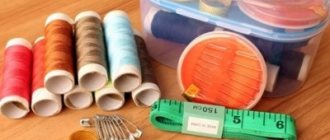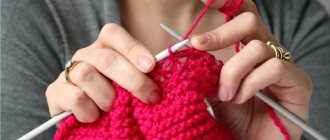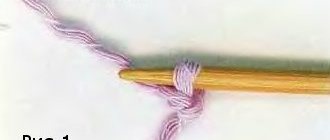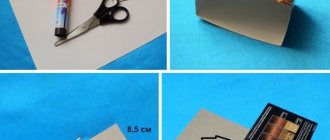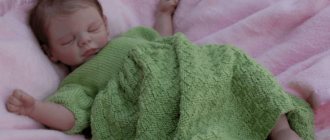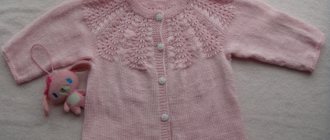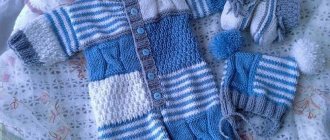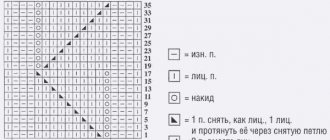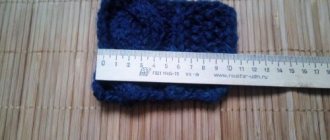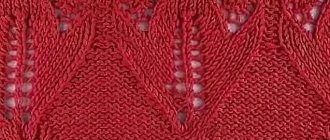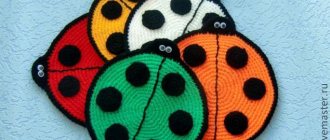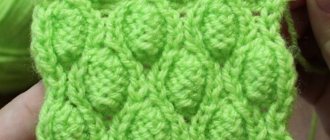When choosing yarn for a sweater, you need to focus on the characteristics and properties of the thread.
These are composition, thickness, twist and a number of other parameters. Important selection factors are the seasonality of clothing and its purpose. A product designed to be worn in a warm office is different from one designed for hunting in a frosty forest and walking along winter streets. In this instruction you will learn how to choose a knitting material, taking into account all the important nuances for men, women and children.
- Main characteristics of yarn for knitting a sweater
- Thickness and its meaning
- Attention to composition
- The Importance of Twist
- Thread quality
- What yarn is best to knit a sweater from?
- Types of suitable wool
- Synthetic threads
- Yarn of vegetable origin
- Fantasy yarn
- Choosing yarn depending on the purpose of the sweater
- Selection based on knitting technique
- Calculation of the amount of yarn
Main characteristics of yarn for knitting a sweater
All winter clothing is subject to more wear and tear than items designed for other seasons. This is due to increased friction against outer clothing during wear. The right yarn can minimize wear and tear and extend the life of the finished item.
Thickness and its meaning
The weight of the final product, its model and design depend on this parameter. The thinner the thread, the lighter and more weightless the thing will be. From thin yarn you can make unusual openwork women's and light children's sweaters.
But threads that are too thin have low wear resistance and require careful and careful handling.
Fashionable thick and super thick yarns, also suitable for knitting sweaters. As a rule, such models are considered designer and are used as an independent piece of outerwear.
It should be borne in mind that it is impossible to make elastic and collars from yarn with a very large cross-section. Also, rough knitting somewhat limits movement.
The most popular thickness of yarn for a knitted sweater: 150-300 m per skein of 100 g. It is easy to work with and can accommodate any designs and motifs. The items are comfortable to wear and do not restrict movement. At the same time, it is quite durable and wear-resistant.
Attention to composition
Despite the wide range of materials on sale, not everyone is suitable for knitting a warm sweater.
Wool threads are rightfully considered the warmest types . The natural properties of wool allow the item to retain heat perfectly. Yarns with additional pile, such as angora or mohair, enhance this effect several times by trapping warm air between the piles.
But there are drawbacks here too. An item knitted from natural wool is extremely capricious, requires careful handling and quickly loses its appearance from frequent use. Some types of wool can prick, causing discomfort.
To reduce negative qualities, mixed species . By adding artificial fiber to natural fiber, the manufacturer improves the characteristics of the thread, making it less capricious and more durable.
It is important to consider here that synthetics do not allow air to pass through well. This may be a good quality for walking outside in the cold, but indoors wearing a synthetic sweater can become unbearably hot. The optimal synthetic content should not exceed 50%.
The Importance of Twist
Given this parameter, it is important to maintain a middle ground. So a tightly twisted, hard, prickly thread will transfer all its properties to the sweater. The product will be rough and unpleasant to the touch.
Clothes may cause irritation and itching where they come into contact with the skin. It is better not to use collars and elastic bands, choosing softer types. Tight twisting makes the thread strong and the product durable.
At the same time, yarn with weak twist or no twist at all tends to stretch, become covered with pills and be damaged by rough handling.
To choose the right yarn, just twirl it in your hand or apply it to your neck or cheek before purchasing. If there are no unpleasant sensations upon contact, you can purchase.
Thread quality
Sometimes, buying many skeins at once, a craftswoman is faced with the fact that the thread breaks during work. Or, as the skein unwinds, defects, thickenings and knots are discovered. This makes the job very difficult. And, since you need a lot of yarn to make a sweater for an adult, it also hits your pocket.
To avoid such troubles, you should purchase products from well-known brands in large specialized stores. New little-known producers and market sellers should be treated with caution.
How to choose yarn for knitting. Yarn composition
Share on social networks!
One of the first questions that arises before we start knitting is what kind of yarn do we need for knitting , which one is better to choose? In order to answer this question, you need to figure out what types of yarn are on sale and what products it is intended for knitting.
- The first thing you need to pay attention to is the composition of the yarn. The composition of the yarn is always indicated on the label
Wool yarn is great for knitting warm clothes: sweaters, warm socks, hats and scarves. This yarn allows air and moisture to pass through well and retains heat well. This yarn has many advantages - it is natural, looks beautiful when knitted, elastic, but, unfortunately, it also has disadvantages - products made from it tend to stretch, and also fall off and form pellets. To avoid this, synthetic threads, usually acrylic, are added to wool yarn - this yarn is called blended yarn. The composition of the yarn, as well as its quality, determines the appearance of the knitted product, as well as how it will behave when worn. As a rule, sheep wool is used to make wool yarn; yarn from goat hair, rabbit hair, and even dog hair is also found.
100% wool - if you see such an inscription on the yarn, it means that it is made from pure sheep wool, without any admixture of other types of threads. It can be of different thicknesses, both very thin - from such yarn you can knit very elegant, well-draped products, and very thick, well suited for knitting hats and scarves with a relief pattern. Medium thickness yarn is good for knitting sweaters, jackets, dresses, vests, and socks.
Merino yarn is the softest and most delicate yarn, made from the wool of merino sheep, usually costs a little more than regular sheep wool. It is thin, so it is well suited for knitting delicate items. This yarn is also good for knitting children's clothes, as it does not irritate the delicate skin of the child.
Shetland
yarn
is made from sheared sheep wool. This yarn is rough but very durable and produces textured knits with a country feel.
Cashmere is made from the combed undercoat of Kashmiri goats. This is one of the finest and noblest types of wool yarn. Products made from it are very warm, wear-resistant and elegant. More often found in a mixture with other types of yarn.
Mohair - This yarn is made from goat hair. This is a thin and fluffy yarn. Previously, Orenburg scarves were knitted from mohair yarn. Mohair, which is quite expensive, is therefore found both in a mixture with sheep wool and with synthetics, often with acrylic.
Angora is a thin fluffy yarn obtained from the wool of Angora rabbits. Also, as a rule, found in combination with wool or synthetic yarn. Products made from angora are thinner, more elegant and less fluffy than those made from mohair.
Alpaca is llama wool, its advantage is that it is very warm, due to the fact that alpaca fibers are hollow inside: they trap air and retain heat. These fibers are long, so alpaca is less prone to pilling.
Acrylic
is a synthetic yarn, often called “artificial wool”. It is characterized by high strength and the ability to be well painted in a variety of colors. As a rule, it is added to various types of wool yarn to increase its wear resistance and reduce cost. But here you need to look carefully, if the acrylic content is small: 10-20 percent, then products knitted from such threads will have all the properties of the main yarn. If the acrylic content is more than 50%, then, as a rule, products knitted from them will have a cheaper appearance, but most importantly, they will not adequately allow air to pass through and retain heat, and therefore will not be very comfortable to wear. You can find acrylic yarn for children's products on sale. But I still wouldn’t recommend it for knitting children’s clothes. Despite the fact that it is hypoallergenic, it still has poor breathability, does not absorb moisture well and is very electrified.
Cotton yarn is a natural yarn used for knitting lightweight summer garments. This yarn allows air to pass through well and gives a feeling of coolness. But this yarn is not elastic, so if you want to knit things from cotton, then carefully choose the yarn. If the thread is heavily twisted, then such yarn will not work; it is only good for crocheting. An example of such yarn is “Iris” thread. The yarn for knitting is slightly twisted, the thread should be soft to the touch. As a rule, such yarn is sold in skeins, like wool. Wool or acrylic can be added to cotton thread to increase its elasticity.
Linen yarn is also a natural yarn, used for knitting summer items. But it is stiffer and less elastic than cotton and is better suited for crocheting.
Silk Yarn - This yarn is obtained from the thread of the silkworm. This yarn is very expensive to make. The thread is very strong, but at the same time, thin and soft, and has a noble shine. Products knitted from silk yarn practically do not pill. In addition to a very beautiful appearance, products made from silk yarn have an important quality - they keep a feeling of coolness well on hot days. This yarn is very expensive to make, so it is often found mixed with cotton or viscose. You can also find silk thread with the addition of synthetic threads.
Viscose is also called “artificial silk”. This yarn is made from wood pulp, spruce or pine. It looks like silk, heavy and smooth, with a slight shine. This yarn conducts air and absorbs moisture, but still not as good as natural threads. It is well suited for knitting items used in the warm season, but on a very hot day you will not feel very comfortable in viscose clothes; it is better to choose cotton or silk yarn for such weather.
Bamboo - Bamboo yarn has recently appeared on sale. This, like viscose, is a cellulose thread, only made from bamboo wood. This is a very strong but soft yarn, with a little shine, and very light. Very good for knitting summer clothes. I advise you to pay special attention to this yarn if you are planning to knit a product for a child. This yarn has unique qualities - it absorbs moisture 3 times more than cotton, does not cause irritation and has an antimicrobial effect, because it contains a natural component that stops the development of bacteria.
- If you have decided on the composition of the yarn, then the second point that you need to pay attention to is the thickness of the yarn and the number of threads that you will need. If you have chosen a model with a description for knitting, then the instructions always indicate the thickness of the recommended yarn. It is determined by the length of thread (in meters) contained in 100 (or 50) grams of yarn. The shorter the length of the thread, the thicker it is. To ensure that the piece you knit is the same size as the pattern in the magazine, make sure you choose a yarn with a similar thickness. Also, the description usually indicates the required number of threads. If you do not have much experience in knitting, then you need to focus on this amount. If you buy less thread than required and you don’t have enough, you may have problems buying more of the same yarn. Often, the label on the skein of yarn also contains information about how many threads are needed to knit a pullover, as well as what size knitting needles are best for knitting this yarn. If you don’t know how many threads it will take to knit the desired product, you can find out here.
- The third point that I advise you to pay attention to is the uniformity of the thread. Carefully inspect the skeins, check that the thread is uniform, without thickenings and knots, as well as thin areas. Be especially careful when choosing skeins of section-dyed yarn - choose skeins that start with the same color fragment, and also pay attention to the fact that there are no broken or tied ends of the threads, because otherwise it will be difficult for you to knit the back and front parts, as well as the sleeves with symmetrical pattern.
I highly recommend keeping the yarn label until you finish knitting the item. Because if you don’t have enough thread, it will be much easier for you to buy the required amount. Try to find threads from the same batch, its number is indicated on the label, because threads of the same color, but from different batches may differ slightly.
Also pay attention to how to care for the knitted product. There are general rules - wash in lukewarm water with the addition of a mild detergent, and gently lay out to dry. But look at the label, it often indicates exactly how to care for this yarn.
These are the main points that you need to pay attention to when you choose which knitting yarn is well suited for the execution of the product you have in mind. If you have any questions or want to discuss something, be sure to leave a comment.
Note! Recently, an article appeared on the site with recommendations for selecting yarn for knitting socks: What knitting needles and what yarn to knit socks from.
What yarn is best to knit a sweater from?
For each sweater model, a different type of yarn is ideal. In order not to make a mistake in choosing, it is necessary to take into account the characteristics of the material.
Types of suitable wool
The most common type of yarn for knitting sweaters is wool. Let's look at some types.
Sheep wool (Wool 100%) is the most common type of warm yarn for knitting sweaters with your own hands. Wool is obtained by shearing sheep. As a rule, to create threads, the fleece is combed out, removing, if possible, all guard hairs.
The amount of spine determines the softness of the thread; the more hairs in the yarn, the coarser and stiffer it is. Barbed thread is not suitable for sweaters as it can irritate the skin.
When choosing wool for work, you must evaluate the softness by touching the skein with your cheek or the inside of your elbow.
Cashmere is traditionally a yarn for women's sweaters. Cashmere items are a symbol of wealth and success. The products are very soft, pleasant to the touch and incredibly warm. Even a thin knitted fabric retains heat perfectly, keeping you warm on frosty evenings.
However, a thin, delicate thread requires careful treatment. And the high price leaves no room for error. Cashmere can be recommended to needlewomen with extensive experience. We tell you more about cashmere here.
Merino is a warm yarn for women's and children's sweaters. It is soft and very warm, does not prick at all and does not irritate the skin. At the same time, it is quite wear-resistant. With proper care, products made from it do not deform and remain in a new condition for a long time.
The work does not require any special skills. The thread is obedient, easily fits into the pattern and remains in it for many years. Merino wool is quite durable and tends to be easily washed off from dirt. In this regard, it can be used to create lightweight men's sweaters.
The main disadvantage is the price - the cost of one 50-gram skein can reach 500 rubles.
Mohair is made from the hair of mountain goats. A very thin silky thread with pronounced delicate pubescence along its entire length. The sweaters are airy, translucent and very fluffy. Products made from mohair, despite their airiness, are very warm. The fluff is soft, does not come out and does not irritate the skin.
The thread has high-quality twist, which makes the work very easy and does not require additional skills. The fluff reliably hides small knitting errors.
One of the features of mohair is the thinness of the thread. The thinner it is, the more effort and time the work requires. However, this property cannot be called a disadvantage, since the small thickness and high strength make it possible to knit things of incredible beauty that have excellent wear resistance.
Angora is the fur of the Angora rabbit. It is obtained by combing and cutting the animal. The thread is very fluffy and soft. The fluff fibers can reach a length of 2.5 cm and retain air well, making the sweater very warm.
However, unlike mohair, rabbit fluff tends to “come out”, which can create some inconvenience when worn. This is especially true for children's sweaters.
When making children's angora sweaters, you should avoid high collars that come into contact with the baby's face. In addition, lint sticks to other clothes, making them look untidy.
Another feature of angora is its strong stalling ability. With prolonged use, the product becomes covered with pellets, and the knitted fabric becomes felt-like over time.
Alpaca is a camel-like animal that lives in the Alpine highlands. Its wool is similar in properties to sheep's, but has much less weight. Things made from this yarn are very light, while maintaining good wear resistance.
The delicate, silky thread does not contain any natural allergens, which is why it is often used to create children's items. It is not subject to pilling and has a wide natural range of colors without the use of dyes.
The main disadvantages include low elasticity. It does not hold its shape well when knitting elastic, stretches and becomes deformed. To design the cuffs of a sweater, you should use a different type or add more elastic yarn to the alpaca.
Camel wool is considered one of the coarsest. When created, fibers from the coarse guard hair of a camel enter the thread. This yarn is warm, but it is very itchy when in contact with the skin and can cause irritation and itching.
One of the positive qualities is the antistatic effect. The item completely extinguishes any static tension created by the friction of clothing. Suitable for knitting men's sweaters and models without a collar.
In addition, this yarn is difficult to dye, so it has a rather meager range of colors, limited mainly to natural shades.
Synthetic threads
Artificial yarns are quite popular among beginning needlewomen due to their low cost and large assortment. Viscose, acrylic and microfiber have a number of undeniable advantages over natural materials:
- quite pleasant to the touch,
- hypoallergenic,
- durable,
- available in a wide range of colors and textures,
- do not require special care,
- have low cost.
However, like any synthetics, they are not without their drawbacks:
- poor thermal conductivity and breathability,
- ability to accumulate a charge of static electricity,
- deformation and loss of shape over time.
Using synthetics to knit a sweater is not the best solution. But adding to natural wool fibers can significantly reduce the disadvantages of the latter.
Blended yarns can be used to knit sweaters of almost any pattern. You just need to pay attention to the percentage of artificial fiber in the yarn. Ideally, the amount of synthetics should not exceed 50%.
Yarn of vegetable origin
Yarns of plant origin are often used to knit light sweaters. Let's look at the most popular of them.
Cotton is an excellent choice for creating openwork and lace designs. Cotton sweaters are an essential part of your summer wardrobe. But it does not retain heat at all, so it is not advisable to use it for warm clothes.
This material is highly breathable, pleasant to the body and holds its shape well. Thanks to the properties of cotton thread, even the most complex and intricate lace can delight you with its appearance for a long time.
Bamboo fiber has a number of important advantages that make it possible to create both winter and summer sweaters from it. Bamboo is highly breathable and has hypoallergenic and antimicrobial properties. This yarn is perfect for creating children's sweaters.
To knit warm sweaters, you can use fancy bamboo yarn - Grass. A large number of fibers retain heat even better. Read more about bamboo for knitting in our instructions.
But when choosing bamboo, it is important to remember that the fabric stretches greatly under its own weight during knitting and wearing. To eliminate this drawback, synthetic and natural fibers are added to bamboo yarn.
You can often find sweater models made from linen, nettle or silk yarn. The use of these threads is largely a design decision and has no practical benefit.
Fantasy yarn
Nowadays a lot of fancy yarn is produced, suitable for knitting bulky women's and children's sweaters. As a rule, the threads are bright, fluffy or interspersed with beads, sequins, and flowers.
Working with such yarn can cause some difficulties, since it is rarely uniform, often tangled, unraveled and torn. But it perfectly hides mistakes in knitting.
The most fashionable and popular fancy thread is thick yarn for a sweater. It is made from merino wool, it has no twist and is a loose rope with a large cross-section.
No tools are required for the work; knitting is done using your hands. When choosing this type, you should remember that the product will be quite heavy and voluminous. This makes it somewhat difficult to use it for its intended purpose.
Another disadvantage of yarn is the price, which can exceed 1000 rubles per skein. Despite the fact that this is a rather weighty ball - about 500 g, it holds no more than 50 m.
For large knitting, instead of thick yarn, other types of fancy threads . For example, tape knitted thread, roving or soft laces. These yarns are the best choice for knitting bulky items, while having significantly less weight.
TYPES OF WOOL
The most impressive are warm clothes knitted from elite varieties of wool: alpaca, cashmere, mohair, merino.
Alpaca
Alpaca is a unique wool of the domestic artiodactyl family of camels native to South America. To avoid having to unravel the product several times when working with wool, be sure to knit samples! Its fibers are seven times warmer and three times stronger than sheep's. Due to the complete absence of organic fats, alpaca is stain-resistant and hypoallergenic, and therefore ideal for making children's clothes. This yarn is also great for knitting a winter hat.
Products made from alpaca do not roll up when worn and are not deformed after washing, and have good temperature-regulating properties. Natural alpaca has 22 natural shades - from white and beige to brown and black.
Yarn characteristics . Soft, smooth, silky, with a pleasant natural shine; comfortable to work with.
What to knit. Alpaca does not hold volumetric designs well, so it is better to choose models made with satin stitch. Usually it is used to knit blankets, cardigans, jackets, sweaters, stoles, shawls, and hats.
Angora
Angora is a very soft, fluffy yarn made from the wool of the Angora rabbit. In its pure form, not many people choose it for knitting due to its high price and poor curling ability. To produce yarn, it is combined with sheep's wool, silk or synthetics. Products made from angora are light (for a size 44 pullover you will need only 250 g) and warm. Hats made from this yarn are especially beautiful.
The disadvantages include wear and care: things quickly begin to “climb” and fall off if they are not washed and dried correctly.
Yarn characteristics . Thin, light, soft, fluffy; may “climb” during knitting.
What to knit . Due to the pronounced fluffiness on angora, braids, arans, and plaits are difficult to “read,” but it is quite suitable for satin stitch and openwork.
Popular products made from angora are pullovers, sweaters, shawls, hats, mittens, and socks.
Cashmere
Cashmere is a yarn made from the down of a mountain goat native to Tibet. It was first produced in the Indian region of Kashmir - hence the name. The raw materials for cashmere are plucked or combed by hand, which is why this yarn is one of the most expensive in the world. It makes very warm, light, soft and durable things. In its pure form, cashmere is highly stretchable, so it is usually added to wool or silk.
Yarn characteristics . Soft, elastic, pleasant to the touch; lies evenly during knitting.
What to knit . It is recommended to use this “precious” yarn to knit basic items that will be worn for a long time and thereby recoup their cost: classic sweaters, pullovers, cardigans. The simpler the pattern, the better the structure and quality of the thread itself will be read.
Mohair
Mohair is a yarn made from the wool of the Angora goat, grown in Turkey, South Africa and Texas (USA). Thanks to its natural snow-white hue, mohair can be easily dyed any color. Premium mohair is the one obtained during the first shearing of kids (kid mohair). The yarn is twice as warm, lighter and stronger than sheep's wool. The consumption of mohair is economical, which offsets its high cost. Mohair is great as a yarn for hats of different types.
Yarn characteristics . Fluffy, light, airy; Working with thin mohair due to its weightlessness requires some skill.
What to knit . Mohair is beautiful in satin stitch and openwork - it will not support raised patterns. Mohair pullovers, cardigans, stoles, and hats look impressive.
Merino yarn
Merino yarn is made from wool sheared from the withers of fine-wooled Merino sheep. Australian merino is valued more than others. Thanks to its natural curl, merino wool holds its shape and volume perfectly. Very warm and non-irritating to the skin, it is ideal for creating children's clothing and items intended for people with sensitive skin.
Yarn characteristics . Dense, soft, elastic; working with it is not difficult.
What to knit . Relief patterns are clearly visible on merino - feel free to choose it for plaits, arans, braids, and various convex elements. Warm sweaters, pullovers, jackets, cardigans, scarves, snoods, hats, voluminous blankets and bedspreads are knitted from merino wool.
Choosing yarn depending on the purpose of the sweater
When choosing yarn for a sweater, you also need to focus on the model of the sweater you plan to knit. Let's consider several options for sweaters, taking into account their purpose.
A women's sweater is the most popular choice of needlewomen. You can experiment with types of threads and patterns, create classic models for all times, and trendy items for one season.
Here it is important to focus on the preferences of the end user, color preferences and desired style.
Traditionally, soft, thin threads of wool, cotton and silk are considered feminine. Increasingly, fancy threads with sequins, beads and lurex are used to create fashionable models of women's clothing.
Sweaters made from yarn of different thread thicknesses, voluminous loops in coarse knitting, fluffy chenille or plush look original. Creating a woman's wardrobe is a creative work; it does not tolerate rigid boundaries and is limited only by the imagination of the master.
Men's sweaters , as a rule, are knitted in a more conservative and restrained style. Color variations are reduced to classic and pastel shades.
The drawing is selected in accordance with the taste of the user. Volumetric horizontal braids, discreet braids, discreet jacquard patterns. You should not use more than two colors at the same time, choosing them in such a way that they contrast or complement each other, but do not look tacky and flashy.
Rough, scratchy sweaters made of camel and coarse sheep wool are welcome in a man's wardrobe. The addition of synthetic threads reduces the wear of the item and simplifies care, which is also an important quality.
Using bright or fluffy fancy yarns, cashmere, mohair or angora is not advisable. In most cases, such a men's sweater will not be popular, but will lie as a “dead weight” in the closet.
Children's sweaters are a special type of clothing that requires very careful selection of yarn. The thread should be soft and gentle, not prick or irritate the skin, and have sufficient elasticity to tightly wrap the child’s neck without causing inconvenience when dressing.
It is important to pay attention to hypoallergenicity, breathability and thermal conductivity. If the choice falls on fluffy yarn, you need to pay attention to the reliability of the fibers in the thread. Constantly emerging fluff can not only spoil the appearance of other things, but also cause inconvenience to the baby, getting into the eyes, mouth and nose.
When knitting children's sweaters, fancy types of yarn, such as plush, chenille, and grass, are very popular. When choosing such yarn, it is important to pay attention to the composition. Manufacturers often use large amounts of artificial fibers to produce them.
Synthetics do not breathe well and can cause diaper rash in the baby. The addition of acrylic, microfiber or nylon to natural thread should not exceed 30 - 40%. There is even more information about choosing material for knitting for children in this article.
How to knit a men's sweater
To please a man with a wonderful new thing, you will have to be patient. After all, this process requires sufficient time and perseverance, as well as attention and scrupulousness.
For the beginner knitter
For beginning craftswomen, complex patterns become a problem. Therefore, it is worth paying attention to models similar to those shown in the photo.
In this sample, the attractiveness and originality of the item is achieved through an unusual color combination . This effect is ensured by the sectional coloring of the yarn.
To knit a sweater with a chest volume of 116 centimeters, you will need 650 g of sectional yarn with parameters 250 m\100 g and straight knitting needles 3.5 and 4.0.
Make a pattern for your future sweater based on the sample, adjusting it to your measurements.
Back detail
Knitting pattern
- Cast on 108 stitches on size 4.0 needles. Complete 6 cm with a single elastic band (1 p.\1 p.).
- Continue working with a purl stitch (in the outer rows everything is knitted as a purl, from the inside as a knit stitch) 48 cm.
- Next, from each edge, knit 4 outer loops in stockinette stitch (in the front rows all the loops are knitted, in the purl rows - purl).
- In every second row to form a pattern, add the number of stitches knitted in stockinette stitch as follows: 1x3 sts; 1x2 p.; 5x1 p.
- In total, you should end up with the following distribution of stitches: 1 edge stitch, 14 knit stitches. satin stitch, purl 78 stitches. satin stitch, 1 edge.
- At a height of 66 cm from the beginning of the edge, bind off the middle 26 loops.
- Then finish both halves separately.
- From the inside in the front rows, knit three knit stitches and two knit stitches (slip the first loop as a knit stitch, knit the second one and pull it through the first loop) 8 times.
- On the inside of the loop, knit according to the pattern.
- At the same time as forming the neckline, decrease the stitches for the oblique shoulder line as follows. In every second row, remove 1x6 sts, 5x5 sts from the outer edge.
- Knit the second side in the same way.
Front part
Follow the same steps as for the back piece , but with a deeper neckline.
This is done as follows. At a height of 64 cm, close the middle 18 sts. To decorate the neckline, remove 14x1 sts from the inner edge. Make an oblique shoulder line in the same way as on the back part.
Side bars (2 pcs.)
On 4.0 needles, cast on 24 sts and knit 6 cm with 1x1 rib.
The order of distribution of patterns looks like this: edge stitch, 3 stitches in stockinette stitch, 16 stitches in purl stitch, 3 stitches in stockinette stitch, edge stitch. After 48 cm from the starting row, finish knitting.
Sleeve (2 pcs.)
- Cast on 4.0 knitting needles to 54 sts and knit 9 cm with 1X1 elastic band.
- Continue working with purl stitch, adding 1 stitch on both sides in every sixth row to make 94 stitches.
- After 52 cm from the start of knitting, form a sleeve cap. To do this, on both sides, remove 1x6 sts, 2x3 sts, 12x2 sts in every second row.
- Next bind off the remaining 22 sts.
Assembly
- Treat the knitted sweater with WTO (wet heat treatment).
- Sew shoulder seams.
- Cast on 100 sts on 3.5 needles along the neckline.
- Tie 6 p. elastic band 1x1.
- Sew the side trims to the front and back pieces.
- Sew in the sleeves.
Youth model
If you are planning to give your boyfriend a handmade gift, then this stylish youth sweater is perfect for this purpose.
Combining brightly colored yarn and an interesting combination of a checkerboard pattern with a convex elastic band, this model is suitable for both a teenage boy and a confident guy.
For knitting, you will need high-quality acrylic yarn with parameters of 120 g per 50 m in the amount of 650 g, as well as knitting needles of two sizes: 3.5 and 4.0.
Before starting work, make a pattern according to your measurements and make calculations based on the related sample.
Back
Get acquainted with the work schemes.
Using 3.5 knitting needles, cast on the estimated number of stitches and knit according to the pattern 1 7 cm.
Next, using knitting needles No. 4.0, continue the fabric with the pattern from diagram 2.
Make a part of the required length by forming a neck.
Before
Proceed similarly to the back part only with a deeper neckline.
Sleeves
- Cast on the estimated number of stitches on 3.5 knitting needles and knit in pattern 1 to the desired length.
- Make allowances for the bevel.
- Form a sleeve cap.
Assembly
Assemble the pieces starting from the shoulder seams. To cut the neckline on the top side, knit 8 r. pattern according to scheme 1.
With a braid pattern
If you already have knitting skills or are willing to take risks to protect your man from the winter cold, turn your attention to arans.
Cable patterns are a suitable option for men's sweaters. They not only create a dense fabric, but also look stylish and emphasize masculinity with their smooth lines .
To make this model a reality, take 650–800 g of wool (240 m\100 g) and knitting needles 3.5 and 4.5. And also follow the pattern according to the sample.
Having chosen the size you need, we knit a sweater according to the available description.
Top to bottom (seamless knitting)
If you want to do unusual work, link this option. The highlight of this method is that the work is done from top to bottom with a single canvas.
Materials for work: 800-1000 g of wool yarn (250 g\100 m), stocking needles 3.0 and 3.5, as well as circular knitting needles of these sizes and a knitting needle for knitting braids.
Attention! With this knitting option, no pattern is made. Calculations are carried out using a linked sample, and the part is periodically tried on to make adjustments.
The process begins by casting on the required number of stitches on 3.5 stocking needles and knitting a collar of the required size. This model uses a 1x1 elastic band with a length of 15 cm.
Then, on both sides for the shoulder straps, one quarter of the total number of loops is counted.
We transfer the remaining two quarters to knitting pins and knit the chevrons in a pattern of braids of the required length.
Continue knitting on knitting needles 3.5. Their number and type are selected individually depending on your size.
We throw the edge loops of the chevrons onto knitting pins.
Next, along the side edges of the chevrons, we collect loops for knitting the front and back elements, including a quarter of the loops from the collar.
The front and back parts can be finished separately or combined into a common fabric at armpit level. A pattern of diamonds is knitted in the center, and braids along the edges. Along the bottom, on 3.0 needles, knit the required number of rows with a 1x1 elastic band.
For the sleeves, cast on the required number of loops along the edge of the floodplain and include the edge loops of the chevrons among them. On the sleeve, continue the braid pattern from the shoulder. Knit the remaining stitches in stockinette stitch. Finish the piece with a 1x1 elastic band.
Pattern options
You can use these patterns to knit braids and diamonds.
Rhombus
Braids
Diagonal elastic
Important! This method requires great skill and skill, as it is performed by eye.
With a "deer" pattern
Another popular men's sweater pattern that is a fashion classic is the Scandinavian deer pattern.
Previously, the bride gave such a sweater to her groom as a talisman of his masculine strength.
Using the description below, it will not be difficult for you to knit this wonderful thing.
Selection based on knitting technique
In many ways, the choice of yarn for knitting sweaters depends on the desired motif. Let's look at the most popular knitting techniques and threads that are suitable for this.
Simple knitting motifs include a large number of patterns that are made by alternating knit and purl stitches. This includes all types of satin stitch, rice, elastic bands. For knitting sweaters using this technique, any wool and synthetic threads of medium thickness are best suited.
A sweater is knitted with a simple satin stitch from thick and almost all fancy yarns. They have a heterogeneous structure and often hide a knitted motif underneath. But even with simple knitting, due to the thread’s own properties, things look quite original, without requiring additional time. An exception may be, perhaps, an elastic band.
Patchwork is a technique for creating a product from scraps made in the form of geometric shapes. In the case of knitting, all elements of the sweater are knitted separately and at the end of the work they are sewn together into a single item.
Almost any yarn is suitable for knitting a sweater using this technique, from simple sheep wool to cotton. You can use yarn left over from previous projects, or purchase thread at a craft store. It all depends on the chosen motif and the imagination of the needlewoman.
You should choose threads for a patchwork sweater so that they all have the same thickness and structure. Regardless of the number of patches and their location, they should all be connected to the same density. With different thread thicknesses, it is not always possible to follow this rule.
Jacquard is a technique for knitting colored patterns and ornaments, from “warm” Scandinavian patterns to intricate bright motifs. Typically, the thread for colored knitting is wool; thanks to its fleecy structure, the pattern is dense and durable.
To choose yarn for such a sweater, you should consider several important points:
- All threads used in knitting must have the same thickness and twist density.
- Fibers with a smooth structure, such as silk, cotton, bamboo, are not suitable for jacquard.
- The yarn must be dyed with stable dyes and not fade when washed.
- Threads that are too thin, combined with loose knitting, can show through, detracting from the overall appearance of the sweater.
Aranas are voluminous weaves and braids created by crossing knitting loops. This is not only an excellent and original decoration, but also additional warmth.
Alpaca and merino threads are most often used for knitting. Wool blend yarns with the addition of acrylic or viscose work well. To make the drawing clear, the thread should be smooth, silky, without fuzz.
The thread should not be too thin. But too thick ones are also not welcome. The best option: 150-300 meters per 100 g.
Openwork knitting is a permanent trend of any season and age. Airy lace sweaters are an important item in a woman's wardrobe. The choice of yarn should be approached with all responsibility; the clarity of the pattern and the appearance of the entire model depend on this.
It doesn’t matter what season the model is designed for. Whether it's a warm cashmere sweater or a summer cotton pullover, the thread should be fine. At least 300 m per 100 g. The thinner the thread, the more airy and weightless the product will be.
You should pay attention to the fuzziness of the thread; the fluff covers the design, hides and blurs the openwork. The long angora pile makes creating lace pointless, completely hiding it. While light fluffy mohair only slightly covers the knitted motif with a light veil of mystery.
Smooth and shiny alpaca thread allows you to create clear, intricate designs. Cotton yarns, silk and viscose are also suitable for this.
When choosing threads for lace, avoid bamboo. A slippery surface tends to pull the knitted fabric, deforming the finished product.
SYNTHETIC, BLEND OR WOOL?
Winter yarn is divided into three main groups: synthetic, blended and wool.
Synthetic yarn consists of fibers obtained through a chemical synthesis process. The main types of synthetic yarn are acrylic, polyamide, polyester, polyester, lurex, microfiber. It is cheaper than natural yarn, wear-resistant, easy to care for, and not eaten by moths. Synthetic fibers are easily dyed in different colors. The choice of shades in their case is very rich.
However, items made from synthetic yarns are often non-hygroscopic and are stiffer and cooler than wool.
Blended yarn is a combined thread of cotton or linen with viscose, as well as all types of wool with the addition of acrylic, polyamide, lurex, silk, etc. Blended yarn is popular among needlewomen due to its affordable price and optimal combination of the best qualities of natural and synthetic fibers.
Wool is a collective term for yarn made from the hair of various animals. Depending on the breed of the animal and the time of year in which the haircut was made, the wool can be hard, prickly - and soft, pleasant to wear. Woolen products retain heat perfectly, are distinguished by a beautiful fit, elasticity and hygroscopicity. Disadvantages include a tendency to stall and form pellets. Almost everything is knitted from sheep wool - from coats and cardigans to hats and socks - and in almost any pattern.
Calculation of the amount of yarn
This is a complex mathematical and experimental process that requires basic knowledge and experience from the master. For beginning needlewomen, it is easier and faster to use ready-made knitting patterns with the quantity and thickness of yarn included with them.
However, if you create a sweater model yourself, you cannot do without calculating the required amount of yarn.
Step-by-step instructions for calculating the material:
- To correctly calculate the amount of yarn for a sweater, you need to create a pattern and calculate the total surface area of the product. Instead of a pattern, you can use a ready-made item.
- Knit a sample measuring 10*10cm, wash it, dry it, calculate its area.
- Unravel the flap and measure the length of the thread.
- Calculate the yarn consumption using the formula: multiply the area of the product by the length of the thread and divide by the area of the sample.
- Divide the result by the length of the thread in the skein, and round the resulting amount up.
Important note : despite the exact mathematical calculation, yarn should be purchased with a small margin, 1-2 skeins.
Knitting women's, men's and women's sweaters is not an easy task. It requires a lot of time from the master and some knowledge about the cut of clothes. The result largely depends on the successful choice of yarn. This issue should be approached responsibly and all pitfalls should be taken into account. Author: Markova Alexandra .
LiveInternetLiveInternet
Which yarn is best for a women's pullover?
CASHMERE
Chic for work and holidays
This material is very popular in the production of knitted items, differing in price, quality and characteristics of the yarn, which can consist of two, three or more threads.
Two-strand yarn produces soft, light and comfortable products, which, however, are quite short-lived.
Items knitted with three or more strands of yarn are also soft and comfortable, but at the same time they look denser and weigh slightly more.
Typically, a women's cashmere pullover, sweater or cardigan should be hand washed with a mild detergent and dried flat. However, make sure that the product label or tag does not indicate a different cleaning method.
Tip: To save money, you can buy knitwear made from a mixture of cashmere and wool. Just 20% cashmere fibers in the yarn will give your clothes an elite look, softness and lightness, and you can wear them even longer than sweaters or cardigans made from pure cashmere.
WOOL
Best choice for cold months
There are several types of wool:
Merino with fine thread. This is an ideal choice for those who don't like scratchy wool. Products made from merino yarn are similar in softness to cashmere, but unlike them they are worn for a long time;
Alpaca is the strongest yarn of all types of wool, but is also very soft;
Sheep wool is thin and soft;
Shetland wool, which consists of coarser threads;
Mohair is a chic, voluminous yarn.
You should care for a jumper, sweater or jacket made of wool according to the instructions attached to them (some woolen items can even be machine washed).
COTTON
Affordable and versatile
Unlike merino or cashmere pullovers, cotton jumpers can be worn in any weather, and they are also easy to care for.
Of course, a cotton sweater is not as warm as a woolen one, but it will also protect us from light frost.
Almost all cotton items can be washed by hand, and some made from a mixture of cotton and synthetics can be washed in a machine, after making sure that this is allowed. Only a mixture of cotton with cashmere or wool requires caution.
FIT KNITWEAR
You must know exactly what type of figure you are. This will help you choose knitwear that will highlight your “charms” without focusing on the shortcomings.
Here are some tips on which women's pullovers, sweaters and sweaters will suit your body type:
If you have narrow shoulders and wide hips, choose a crewneck jumper that will enhance your upper body. This will make your hips visually narrower.
If you want to look slimmer, preference should be given to women's pullovers with a V-neck or with vertical details (folds, stripes, etc.). By the way, jumpers with such a neckline, as well as with a wrap, can be recommended for all women, they are truly universal .
CUT-OUT PULLOVER
It is very important to choose a knitwear product with the correct neckline.
The most popular and in demand is the V-shaped neckline. It not only slims and makes the figure more proportional, but also “opens” the face. The boat neckline is the most insidious. Only tall girls with long necks can wear it. He will make the figures of everyone else squat, and besides, he will reduce your height. Therefore, it is better to opt for a pullover with a deep neckline. Source: https://women-on-line.ru
Tip four: carefully read the ingredients
Once you have decided on the diameter of the knitting needles, the color and the required amount of yarn, it is worth studying the composition. Let's start with the fact that yarn can be both natural and synthetic. Natural varieties include alpaca, angora, cashmere, linen, merino wool, mohair, cotton, silk and wool. Synthetic ones include acrylic, viscose and lurex. All types of yarn have their advantages and disadvantages, which should be taken into account before starting work.
Alpaca is the name for the wool of llamas of the same species, very dense and warm. Pure alpaca is expensive and is therefore often mixed with additives to reduce the cost. Blends with acrylic and merino wool are very common, but 100% alpaca is always popular, despite its high cost. Among the advantages of this type of yarn, it is worth noting its excellent thermoregulatory properties - it warms well in the cold and cools in the heat. It also dyes well and, thanks to the long fibers, almost does not fall off. The only disadvantages include the high cost of the material and storage features. For such yarn, you cannot use naphthalene - only natural products (lavender, tobacco and cedar).
Angora is the name given to the down of a special breed of rabbit. Angora wool is very soft and warm. Also a big plus is its wear resistance - you can carry a product made from high-quality angora for more than one year. But this type of yarn has many disadvantages. Angora quickly “peeles” because the fluff does not attach well to the wool fibers, and this cannot be prevented. Pure wool of this type is not often found because it is traditionally mixed with merino and acrylic. Also, products made from this type of yarn cannot be washed - they are only dry cleaned.
Cashmere is a yarn made from the down of mountain goats. It is very pleasant to the touch, and the products are visually perfectly smooth. Cashmere is also warm and light due to the fact that the fibers are thin and hollow inside. Products made from this type of yarn are easy to care for, they are absolutely non-prickly and do not cause allergies. The big disadvantage of cashmere is that the yarn quickly becomes covered with pellets. And of course, the price is very high - goat wool is combed out by hand during the molting period and sorted according to the length and width of the fibers. Cashmere is also capricious when dyeing - it can only be tinted by hand.
Linen yarn is the strongest of all natural types. Thanks to its natural antibacterial properties, it is easy to store because it is minimally susceptible to spoilage. It does not shrink or stretch over time, retains heat well and absorbs moisture. Unfortunately, linen does not dye well and is difficult to bleach, so the color palette is limited to natural beige tones. In addition, this type of yarn wrinkles a lot, weighs more than cotton, and looks quite rough.
Merino yarn is a yarn made from the wool of sheep of the same breed. It is warm, long, elastic, but much more expensive than usual, because only wool from the withers is taken to make the yarn. This process is very expensive and time-consuming, but thanks to such strict selection, merino wool does not irritate the skin and looks great for quite a long time. The disadvantages of this type of yarn include all the “whims” of woolen products - they require careful care, only hand washing and laying dry.
When they say “mohair,” an immediate association arises with an oversized, scratchy sweater from grandma’s chest. But it's actually just a pretty fluffy yarn made from goat hair. The main feature of this type is that it cannot be “pure”: during processing, the fibers disintegrate into small hair and therefore the mohair content in the yarn can only be partial (maximum 83%). Therefore, despite the fact that natural mohair is easy to clean and can be dyed, it is mainly mixed with acrylic or regular wool, washed by hand and using a delicate shampoo.
Cotton is a yarn of plant origin, known since the 7th century BC. It is hygienic, resistant to alkali, almost does not shed, is well breathable and absorbs moisture. Cotton is comfortable, pleasant to wear, easy to care for and hardly loses color. It is stronger than wool, but not as durable as linen and silk. In addition, it holds heat poorly and is completely inelastic.
Silk thread, in turn, is very durable and retains heat well, practically does not form pellets and absorbs moisture well. But silk products are difficult to care for - they cannot be washed. For knitting, this type of yarn is used in blends.
Wool is a natural fiber that is almost impossible to compete with synthetics. This is a collective name for types of yarn made from the wool of various animals. The great advantage of almost any wool is its softness, good fit and resistance to creasing. But how sensitive she is! Wash a wool item in water at the wrong temperature and it can stretch out or become the size of a thimble. Low-quality wool is also very itchy and can cause allergies.
It’s good that acrylic was invented precisely for such cases - this synthetic fiber is often called artificial wool. Products made from pure acrylic do not fade; they make ideally warm things that do not lose their shape and are pleasant to the touch. It is very good for beginner knitters and is suitable for machine knitting. But despite all its advantages, this type of yarn does not absorb moisture well, and this affects its hygiene.
The second most popular after acrylic is the world's first artificial fiber - viscose. It was invented by industrialists at the end of the 19th century, but it is still popular today. It is mixed with cotton, acrylic, mohair and wool. The result is bright, hygienic and very high-quality items that do not accumulate static electricity. It’s true that viscose is often capricious when washed - if you wring it too hard, the fabric stretches and loses its shape.
Lurex is the most elegant type of yarn. Thanks to inclusions of shiny metallic threads, it can easily decorate even the simplest item, but at the same time it is terribly prickly and is used mainly in things with a lining. It is also complex in composition and does not tolerate washing well.
Best Plush Yarn
The most delicate material for knitting. Incredibly soft and hypoallergenic, properties that a good baby yarn should have. Used for knitting toys and things for babies. Having studied the reviews and recommendations of needlewomen, the VyborExpert.ru team identified two items of the best plush yarn.
Alize
Plush thick threads for knitting from a Turkish manufacturer consist of high-quality 100% polyester, which has hypoallergenic properties, holds its shape perfectly, and retains its rich color for a long time. Used for children's things, blankets, toys.
Fluffy thread, gathered into loops of the same size, forms an even, soft fabric that is pleasant to the body. The products are dense, light, and incredibly soft. For work, it is recommended to use knitting needles No. 3-5, hook No. 2-4. A skein weighing 100 grams contains 9 m of plush thread.
Advantages:
- Large assortment of shades.
- The pile does not roll down.
- The yarn does not fade.
- Hypoallergenic properties.
- Pleasant to the body.
Flaws:
- Synthetics.
- Small footage.
Knitted plush products cannot be machine washed. It is not recommended to twist it, otherwise the canvas will lose its shape.
YarnArt
Plush yarn made from 100% polyamide. The thread is evenly covered with soft, silky, dense pile. Both visually and tactilely imitates fur similar to mink wool. Recommended for knitting outerwear, pillows, toys, blankets, and interior items.
The palette is small, mainly consisting of beige, pink, and blue shades. These threads make warm, effective children's jackets. For work, it is recommended to use a hook No. 6.5, knitting needles No. 6-7. The weight of the skein is 50 g. The length of the thread is 75 m.
Advantages:
- Large selection of shades.
- Imitates fur.
- Hypoallergenic.
- Thick, voluminous thread.
- Good footage.
Flaws:
- Synthetics.
- When knitting, the loops are difficult to see.
The pile of plush threads falls off when unraveling, which affects the appearance of the re-knitted product. Even after frequent washing, plush products do not lose their shape.
